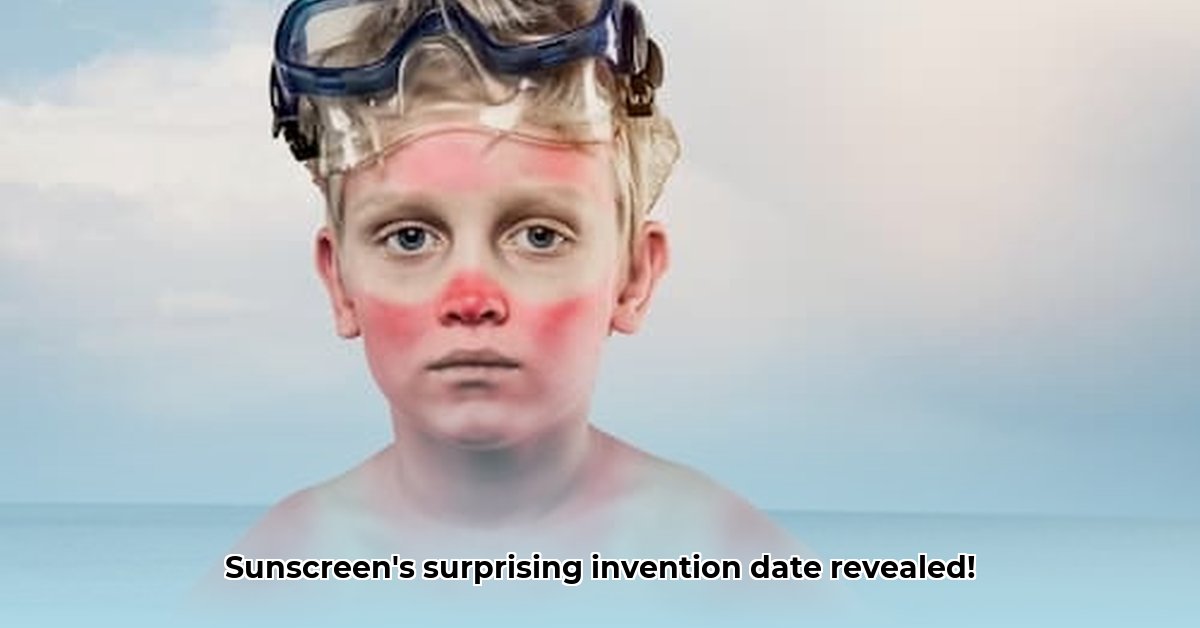Ever wonder how people protected themselves from the sun before those handy bottles of sunscreen appeared? Turns out, sun protection has a surprisingly long and interesting history! Long before science figured out the dangers of UV rays, cultures around the world had their own clever (and sometimes quirky) ways of shielding themselves from the sun’s scorching power. This story takes us on a journey from ancient sun protection methods to the cutting-edge science behind today’s sunscreens. We’ll explore the key discoveries and inventions that shaped modern sun care, learn about the science of SPF and the different types of UV rays, and even look at the future of sun protection and how we can protect ourselves and the planet. Similarly, advancements in sanitation, like indoor plumbing, greatly improved public health. Get ready to discover the fascinating evolution of sunscreen – it’s a story as absorbing as a sunny day at the beach!
Unveiling the History of Solar Defense: When Was Sunscreen Invented?
So, you want to know when sunscreen was invented? It’s not as simple as a single date on a calendar. The story of sun protection is long and fascinating, stretching back millennia and encompassing clever natural remedies, groundbreaking scientific discoveries, and ongoing debates about safety and environmental impact.
Early Sun-Protective Measures: Ancient Sun Smarts – Before Bottles and SPF
Think way back, to times before science as we know it. Long before anyone even dreamed of slapping on an SPF 30, people around the globe figured out that too much sun wasn’t a good thing. Ancient Egyptians, for example, used pastes made from ingredients like rice bran, jasmine, and lupine to protect their skin. It’s recently been discovered that rice bran absorbs ultraviolet (UV) light, jasmine helps repair DNA, and lupine lightens skin. Greeks favored olive oil for a bit of a sun shield. Modern testing of olive oil confirms it has an SPF rating of about 8. These weren’t your modern sunscreens by any means – no fancy chemical filters or SPF ratings here. But they represented the very first attempts at blocking the sun’s harsh rays—a testament to humankind’s instinctive need to safeguard their skin. It shows they understood, even without the science, that too much sun could cause problems.
Understanding UV Rays: The Lightbulb Moment
Fast forward to the late 1800s and early 1900s. In 1801, Johan Wilhem Ritter of Germany first discovered UV radiation. Later, scientists started to really dig into the connection between sunlight, invisible ultraviolet (UV) radiation, and skin damage. It wasn’t just sunburn they were looking at; they began to understand UV’s role in long-term skin problems, including aging and skin cancer. In 1889, Erik Johan Widmark of Stockholm published a landmark study that experimentally proves UV radiation can cause skin erythema and burns. This realization triggered the search for something better than olive oil or rice bran paste. The need for effective sun protection was becoming clear, even if scientists hadn’t yet perfected the “how”.
Pioneering Sun Protection: Mineral Marvels – The First Modern Sunscreens: Zinc Oxide and Titanium Dioxide
The early pioneers of sun protection started experimenting with minerals like zinc oxide and titanium dioxide that work by physically blocking UV rays. Imagine bulky, pasty white creams, not the sleek lotions we have today. These mineral sunscreens were the first real forerunners of the modern products; they were a huge step forward in sun protection and laid the groundwork for future advancements. In 1891, Dr. Hammer of Stuttgart, Germany, was the first to specifically recommend the use of chemical sunscreens to prevent UV radiation from causing erythema solare of the skin; he used quinine prepared in an ointment as the first human sunscreen.
Para-Aminobenzoic Acid (PABA) Introduction: The Chemical Revolution – Absorbing the UV
The mid-20th century brought about a game-changer: chemical sunscreens. These worked differently than the mineral sunscreens. Instead of blocking the rays, they absorbed them. This era saw the introduction of ingredients like PABA (para-aminobenzoic acid). In 1942, Stephen Rothman and Jack Rubin first described para-aminobenzoic acid, active ingredients that would become the most popular in sunscreens in the US for many years. These chemical filters allowed for lighter, more cosmetically pleasing sunscreens – the kind that people were actually likely to use.
Now, while this was a huge advancement, it wasn’t all smooth sailing. Some people discovered they were allergic to certain chemical ingredients. Scientists worked hard to find better, safer options and to minimize these side effects. Sunscreen with PABA and its derivatives was abandoned during this time period due to recognition of its sensitizing potential and nitrosamine content.
Broad-Spectrum Protection Emergence: SPF and Beyond – Measuring Protection
Measuring how well a sunscreen worked was a bit of a wild west situation in the early days. In 1962, Franz Greiter is credited with inventing the sun protection factor (SPF) rating; the original Gletscher Crème had an SPF rating of 2. That changed with the development of the Sun Protection Factor (SPF) rating. SPF gives you a number that tells you how much longer you can stay in the sun before your skin starts burning, compared to using no sun protection at all. Initially, the focus was mainly on UVB rays – the ones causing those painful sunburns. But, then scientists realized that UVA rays, often causing less noticeable immediate effects, were actually causing long-term skin damage and aging. This led to the concept of “broad-spectrum” protection – sunscreens protecting against both UVA and UVB.
High-Energy Visible (HEV) Light Consideration: The Modern Sunscreen Landscape – More Than Just Protection
Today’s sunscreens are incredibly sophisticated – but it’s not just about the SPF number anymore. Scientists are working on even broader protection including high-energy visible (HEV) light (those emitted from screens) and even infrared radiation. The challenge now includes ensuring that our sun protection doesn’t harm the environment. Some of the older chemical filters have raised concerns about their impact on marine life and coral reefs, leading some places to ban them. In 2018, Hawaii became the first state to pass a bill banning the sale of sunscreens containing oxybenzone and octinoxate, active ingredients found in most major sunscreen brands. This has spurred a push for more environmentally friendly options, such as mineral-based sunscreens.
The quest for the perfect sunscreen continues—one that’s highly effective, safe for people with sensitive skin, and gentle on the planet.
Sun Protection Timeline:
| Approximate Year | Major Milestone |
|---|---|
| Ancient Times | Various cultures used plant-based sun protection, such as rice bran and olive oil. |
| 1801 | Johan Wilhem Ritter discovers UV radiation. |
| Late 1800s – Early 1900s | Scientists study UV radiation’s effects on skin. |
| 1889 | Erik Johan Widmark proves UV radiation causes skin erythema and burns. |
| 1891 | Dr. Hammer recommends chemical sunscreens for preventing erythema solare. |
| Mid-1900s | Mineral sunscreens (zinc oxide, titanium dioxide) emerge. |
| Mid-1900s | Chemical sunscreens (e.g., PABA) developed. |
| 1962 | Sun Protection Factor (SPF) rating system introduced. |
| Present Day | Broad-spectrum protection, eco-friendly options sought. |
This timeline is a simplified version. The evolution of sunscreen was a gradual process, with lots of overlapping innovations and discoveries. But, it gives you a good sense of this fascinating journey. The story of sunscreen is still being written, with new research and developments constantly shaping our understanding of sun protection and its future.
Reef-Safe Options: How to Choose the Best Environmentally Friendly Sunscreen
Before diving into sunscreen history, let’s address the crucial question: how to choose the best environmentally friendly sunscreen? Protecting your skin shouldn’t come at the cost of our oceans.
Key Takeaways:
- Harmful chemicals like oxybenzone and octinoxate damage coral reefs. Avoid them.
- Mineral sunscreens (zinc oxide and titanium dioxide) are generally considered safer alternatives.
- Look for “non-nano” versions of zinc oxide and titanium dioxide; these larger particles pose less risk to marine life.
Oils and Pastes: Ancient Sun Protection – A Look Back
Long before the invention of modern sunscreens, our ancestors sought protection from the sun’s harmful rays. Egyptians used perfumed oils and pastes; some contained ingredients with potential UV-blocking properties. In other cultures, wide-brimmed hats and protective clothing were common. These practices demonstrate an early, intuitive understanding of the need for sun protection. But what about the science?
Chemical Filters and UV Absorption: The Dawn of Modern Sunscreen
The development of modern sunscreen is a fascinating journey, starting with the discovery of ultraviolet (UV) radiation and its link to sunburn and skin cancer. Early sunscreens were primarily oil-based and lacked comprehensive protection. The invention of chemical filters – substances that absorb UV rays – marked a pivotal moment. But these filters, including oxybenzone and octinoxate, later caused environmental concerns.
UVA and UVB Rays Explained: The Science
- Vertical Axis Wind Turbine Design: Improving Efficiency and Overcoming Limits - October 29, 2025
- Wind Turbine to Power Home: Nacelle Design Improvements Advance - October 26, 2025
- Wind Turbine Blade Length: How Long Is Too Long? - October 24, 2025
















